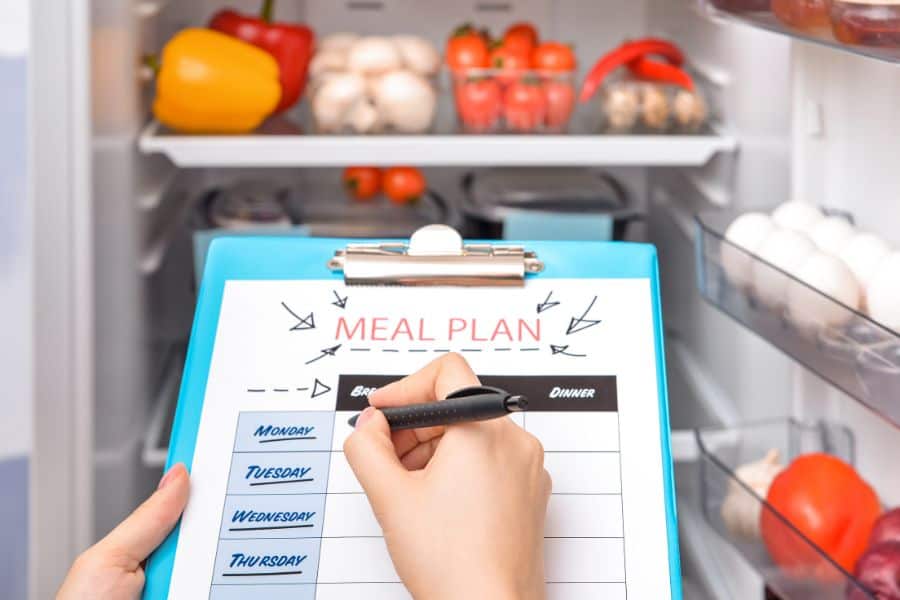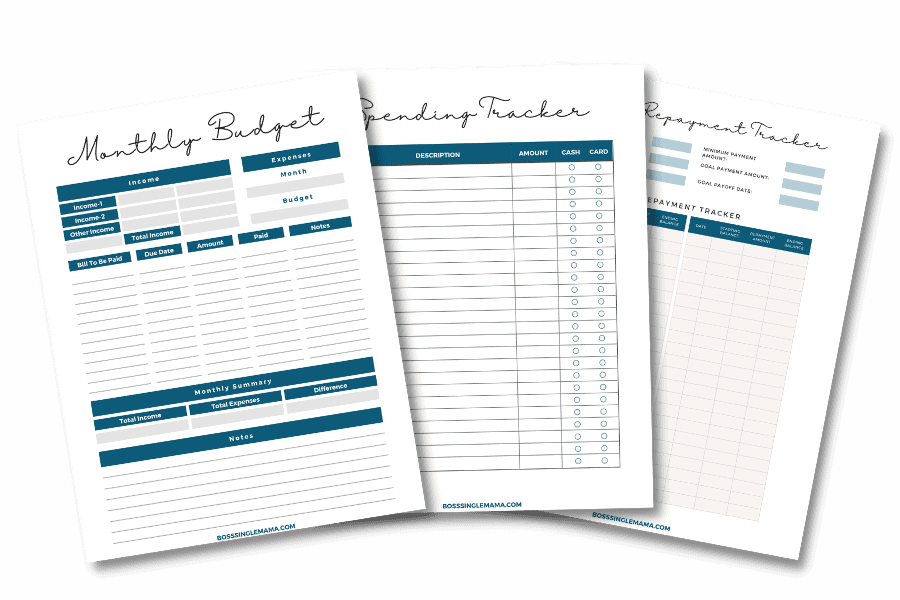Last Updated on June 24, 2023 by Rebecca Lake
Need some ideas for how to afford groceries on a budget?
A high grocery bill can easily eat up a big chunk of your household budget. According to the Bureau of Labor Statistics, the average American household spends $4,942 on food at home each year. Another $2,375 is spent on food away from home.
Fortunately, it’s possible to buy groceries on a budget without spending a lot of money or wasting hours clipping coupons.
Some of the best ways to curb grocery costs include opting for generic brand items over name brands, comparing food prices at each local grocery store you have access to and planning meals around inexpensive pantry staples.
If you’re ready to cut your food spending, you can use these tips for buying groceries on a budget as a starting point.

LIKE FREE MONEY?
Here are some of my go-to apps for earning extra cash!
Survey Junkie. Earn up to $50 per survey just for sharing your opinions.
Swagbucks. Make money by playing games and watching videos. Join for free and get a $10 bonus when you sign up!
InboxDollars. Take surveys and get paid, no special skills or experience required!
Rakuten. Earn up to 40% cash back at hundreds of retailers, online or in stores. And get $30 for each person you refer, along with a $10 sign up bonus!
CashApp. Need a simple app for sending and receiving money? Get $5 free when you use code ‘VZXRXZN’ to join CashApp.
Table of Contents
35 Realistic Ways to Afford Groceries on a Budget
Trimming your food bill may seem a little daunting, especially if you have growing kids. When inflation drives up the cost of food, that can make planning a monthly grocery budget even more challenging.
That’s where finding ways to buy groceries on a budget becomes crucial for stretching every food dollar you spend.
1. Start meal planning
Meal planning is such a huge help when you need to purchase groceries on a budget. When frugal meals are planned out, it’s much easier to stick to your grocery shopping list and avoid impulse purchases.
At our house, we have a dozen or so staple meals that we rotate through every couple of weeks. And once a week I try to make something new that we haven’t had before to see if we want to add it to the rotation.
If you don’t know where to start, you’ll want to read this beginner’s guide to meal planning on a budget.
You can also check out $5 Meal Plan if you need some inspiration or ideas for meals.
$5 Meal Plan is an online meal planning service that provides you with a list of inexpensive meals you can prepare each week. You can sign up and get meal plans delivered to your inbox for easy menu planning.

Need help with meal planning?
$5 Meal Plan is a weekly meal planning and prep tool that can help you save money and time in the kitchen. For just $5 per month, you can get a made-to-order meal plan to feed your family for less than $2 per person, per meal!
2. Change your meal mindset
Rethinking the way you approach family meals can help you stick to a frugal grocery budget. Rather than sticking with a traditional meal plan, you might try experimenting a little. It’s a simple frugal food hack that can test your creative skills!
Here are a few meal idea options that could save a lot of money:
- Meatless Monday
- Appetizers as dinner
- Simple three-ingredient recipes that utilize pantry staples
- Recycling leftovers into new meals
- Having breakfast for dinner
Making small changes to your family menu can have a big impact on how much money you spend on groceries each week or each month. And it can be an opportunity to try out new recipes or meal ideas, which is great if you’ve fallen into a meal planning rut.

3. Try freezer meals and make-ahead meals
Freezer meals and make-ahead meals are a good idea when you don’t have much time to cook. You can batch cook them, pop them in the freezer, then pull them out when you’re ready to eat them.
Planning make-ahead meals around a core group of pantry staples (like pasta, rice, dry beans, etc.) can slash food costs if you’re able to purchase those items on sale. Those are all excellent items to add to a cheap grocery list.
And freezer meals can also be healthy meals if you’re making them with foods that freeze well and are high in nutritional value.
4. Shop your pantry first
One of the easiest ways to buy groceries on a budget is to shop your pantry before heading to the grocery store. It’s possible that you might have a slew of pantry staples and other items that you can use to create some cheap, healthy meals.
Maintaining a pantry inventory can be an easy way to save money grocery shopping. You can check your pantry inventory against your shopping list to see what you already have, so you don’t waste money buying things you don’t need.
Some examples of good things to keep on hand in a pantry include:
- Canned goods
- Spices
- Pasta
- Pasta sauce and pizza sauce
- Flour and yeast (to make your own pizza crust!)
- Sugar
- Peanut butter or other healthy nut butters
- Olive oil or cooking oil
- Dry goods, like cereal and oatmeal
- Root vegetables that store well, like sweet potatoes and onions
Remember to check expiration dates regularly for dry goods and canned or jarred foods. If you see something is getting close to its expiration date you can incorporate it into that week’s meal plan so it doesn’t go to waste.

Take Control of Your Budget!
Grab these FREE budgeting printables and get your finances on track when you join the weekly newsletter!
5. Separate needs from wants
Separating food needs and wants is so important when you’re buying groceries on a budget. If buying cheap groceries is a priority, then it’s important to make every penny count.
For example, staple items like pasta or ground beef might be a need if you plan to stretch those ingredients into several different meals for the week. But things like chips, ice cream or convenience foods that require little to no preparation are wants.
Creating a weekly or monthly food budget and analyzing your past grocery spending can help with sorting out needs and wants. Once you make your budget, you can go back through it to see if there’s room to add in one or two “extras” like a fun snack for the kids or a sweet treat for yourself.
6. Always shop with a list

Having a list for grocery shopping (and sticking to it) is one of the easiest ways to buy groceries on a budget. When you have a list to follow, there’s no room for impulse purchases or spending extra money on non-essential.
Here’s a simple way to test this theory. Make two trips to the grocery store, one with a list and one without. Then, compare what you spend on each shopping trip.
Don’t be surprised if you find that you spent more on grocery purchases when shopping without a list. Making a grocery list can seem a little tedious but you can simplify things by recording it on your phone.
7. Avoid grocery shopping when you’re hungry
Grocery shopping while you’re hungry almost guarantees that you’re going to end up spending extra money. Research has shown that shopping on an empty stomach could cause you to spend 60% more and buy more non-food items in the grocery store.
The next time you’re about to head out to the grocery store, grab a snack first. Or plan your shopping trips for times after you’ve had a meal so you’re less tempted to grab extras that aren’t on your grocery list.
8. Get to know grocery sales cycles
Grocery stores use a set sales cycle to decide when to put different items on sale. Learning the sales cycle at your local grocery store or stores can help you pinpoint when you’re likely to find the best deals on the things you buy regularly.
Depending on your store, items might cycle through on sale every six, eight or 12 weeks. Or your store might only run sales on specific days of the week, like Wednesday through Sunday.
Sales cycles are typically grouped around similar items. For example, it’s not uncommon to see breakfast food (i.e., cereal, oatmeal, breakfast bars, pancake mix, etc.) go on sale at the same time.
A good way to learn your store’s system is to keep track of price changes for the items you buy regularly in a notebook or the notepad app on your phone. You can divide the list by store brands and name brands or by food category (i.e., fresh produce and fresh fruits, dairy, meats, etc.).
When in doubt, you could always ask the store manager how their sales cycle runs. That can help you get ahead of the game when planning to buy groceries on a budget.
9. Compare grocery prices before you shop
Comparison shopping is essential for getting a good deal on groceries. Something might look like a good price at first glance but you might be able to find it cheaper at a different store.
There are several ways to compare grocery prices.
For example, you can visit each store’s website to check their online flyer. Or you can scan the flyers that come with your newspaper.
You can also use the Instacart app to check grocery prices. When you log into the app, you can compare prices at different stores in your area for each item on your shopping list.
You can toggle back and forth between stores to see who’s got the better deals and what the grand total might be if you were to purchase those items.
10. Enroll in grocery loyalty programs
Grocery store loyalty programs can be instant-money savers when buying groceries on a budget. Depending on which stores you shop at, you might be able to get access to coupons, special offers or promotions when you join.
Some stores require you to log in to their mobile app to activate coupons while others apply promo codes automatically at checkout. Either way, that can be easier than clipping paper coupons each week.
As an added plus, some grocery store loyalty programs (like Kroger and Lowe’s Foods) also let you use your loyalty card to save money on gas.
11. Know the cheapest foods to buy

Saving money buying groceries on a budget and eating healthy don’t have to be mutually exclusive. You can still feed your family nutritious food without breaking the bank.
The secret is knowing the cheapest foods to buy and when to buy them.
Again, the cheapest foods tend to be staple items and fresh items that you can incorporate into a lot of different meals. Some of the most affordable cheap healthy food options include:
- Pasta
- Dry beans and canned beans
- Canned vegetables
- Rice
- Ground chicken or ground turkey (cheaper than ground beef and healthier, too!)
- Sour cream
- Cottage cheese
- Whole grains
- Whole chicken (you can turn a single rotisserie chicken into multiple meals)
Any of these items could be a great addition to your grocery shopping list when trying to save money on food.
12. Decide whether you want to shop in-store or online
Online shopping can save money if you’re able to find the lowest prices and it can save time as well. And there are several options for buying groceries online.
Walmart Grocery
Walmart Grocery allows you to shop through an app, then pick up your groceries at the store at a scheduled time.
Here’s how it works:
- Download the Walmart Grocery app
- Create an account using your email and set your preferred store location
- Choose a time you want to pick up your groceries
- Shop and add items to your cart
- When you’re done shopping, check out and pay
Once you send in your order, your shopper fills it. When your order is ready, you’ll get a notification letting you know you can come to pick it up.
You check in with the app to let Walmart know you’re on the way. Then you drive to the store, pull into one of the assigned spots for grocery pickup and wait for someone to bring your groceries out.
Target Grocery
Target also lets you shop for groceries online and pick them up at your local store. Or, you can order certain items and get them delivered the same day with Shipt. (An extra fee applies if you’re not a Shipt member.)
Shipt grocery delivery isn’t available in all of Target’s markets. But if you live in a covered area, it’s an easy way to do your grocery shopping online so you don’t have to leave the house.
And of course, you always save 5% and get free shipping for items you buy online from Target all the time when you use your REDCard. That’s a nice extra perk to help you save money when buying groceries on a budget.
AmazonFresh and Prime Pantry
AmazonFresh and Prime Pantry are two different options for ordering groceries online with Amazon.
AmazonFresh is a delivery service that’s available in selected markets across the U.S. Prime Pantry is a delivery service for grocery and household staples.
Either one could help you save money on groceries, depending on what you buy.
You’ll need to be an Amazon Prime member to use AmazonFresh. And being a Prime member also means you can save money on shipping for Prime Pantry orders.
Instacart
Instacart is one of the best mobile apps for online shopping when you need groceries fast.
Here’s how it works:
- Download the Instacart app and create an account
- Choose which store (or stores) you want to shop at
- Add items to your cart and when you’re done shopping, check out and pay
- Your Instacart shopper goes to the store and shops for your items
- Pick up groceries at the store or have them delivered
Instacart is great if you want a streamlined grocery shopping experience. You pay through the app and get groceries in an hour or two after ordering them.

13. Choose pick-up if you’re grocery shopping online
If you’re shopping online for groceries, you have two options for getting your items: pick-up or delivery.
Getting groceries delivered will definitely save you time. But it’ll cost you, too since you have to pay a delivery fee. You may also pay a surcharge for heavy items like bottled water and pet food.
Not to mention, your shopper might expect a tip if you’re using Instacart or Shipt.
So if you want to buy groceries on a budget online, stick with the pick-up option. It’s free and it can still save you time, too since you didn’t have to shop for your groceries in the store.
14. Use promo codes to save on online shopping
A simple way to save money when buying groceries online is to apply promo codes good toward your first purchase.
With Walmart Grocery, for example, you can get $10 off your first time shopping. Instacart offers the same deal.
If you’re shopping with a chain other than Walmart and you’re not using Instacart, check the store’s website to see if a coupon or promo code is available for your first order.
You can also scout out coupon sites like RetailMeNot for first-time shopper promo codes.
15. Buy staples first
Staples are the things you might buy week to week and always keep stocked in your pantry. Flour, sugar, cooking oil, eggs, milk — that kind of thing.
Shopping for staples first when buying groceries on a budget is smart because it keeps you from getting distracted and filling up your cart with unnecessary items.
Plus, those items typically don’t see huge swings in pricing from one week to the next. And remember that store brand items are almost always going to be cheaper than name brands.
16. Shop sale items next
Once you’ve got the staples out of the way, then check out what’s on sale. Remember, though, that you’re only looking for sale items that you can work into your meal plan.
Buying things just because they’re on sale can end up being a waste of money if you don’t use them.
Also, if you’re shopping through Instacart or your grocery store’s app, check to see if there are any digital coupons you can apply for added savings.
17. Know your store’s layout
Grocery stores typically follow the same layout, with certain food items grouped in specific locations. While you might not realize it, where you shop in the store can influence how much you spend.
Shopping the outer aisles of the grocery store can save money on food costs if you’re buying things like fresh fruits and fresh produce, lean meats and dairy. The middle aisles, meanwhile, are where you’ll find all the pricey, processed foods.
If you want to buy groceries on a budget, then understanding your store’s layout can help you zero in on where the healthy foods are while avoiding the “junk”.
18. Maintain a favorites list
Creating a favorites list can save you time and money when buying groceries on a budget. Your favorites list includes the things you buy regularly.
When you log into Instacart, for example, you can go to your favorites list and add anything you bought from the previous week that you want to buy again. Walmart’s grocery app will even let you create your entire cart from one week to the next.
It’s a great time-saving and money-saving hack if you’re buying the same things most weeks. And if you bought something last week isn’t on sale this week, you can just remove it from your cart with the tap of a button.
19. Use GetUpside to earn cashback

GetUpside is an easy way to save money on grocery shopping and gas. You can earn cash back when you shop at partner stores for food or other items.
Depending on where you prefer to shop, you might also save money by using Rakuten. Rakuten is another cash back app that pays you money just for buying things that you normally would.

Want to Get Cash Back When You Shop?
Making extra money is easy with Rakuten!
Rakuten is a free app and browser extension that helps you find coupons and discounts when you shop online or in stores. You can earn up to 40% cashback when you shop at hundreds of partner retailers, plus get a $10 sign-up bonus and up to $30 in bonus cash for each person you refer!
20. Consider buying in bulk
Buying in bulk is a good way to afford groceries on a budget if you’re using all of the items you purchase. Discount stores and warehouse clubs are great places to purchase large packages of food staples, as well as paper products like toilet paper and paper towels.
If you’d like to shop online, you could use Amazon Prime Pantry to buy in bulk. And you may be able to buy certain items in bulk from Walmart stores, though there may be limits on the number of items you can purchase.
Getting 50 cans of diced tomatoes for $0.25 each is a great deal. But unless you’re planning to can or jar your own pasta sauce or pizza sauce, it might take you forever to eat your way through them.
21. Shop in season
Shopping in season is another way to save money on food costs, since seasonal items tend to be cheaper.
You can try local farmer’s market to find seasonal fruits and vegetables at a discounted price. If you don’t have a farmer’s market nearby, check out this guide to buying seasonal foods.
22. Avoid the eye-level zone
Grocery stores can play lots of mind tricks to get you to spend more money. One of them is placing the highest-priced items at eye level.
And that’s actually pretty smart. You put the most expensive items where shoppers can easily see them so they’re more likely to buy them.
But that doesn’t help you if you’re trying to buy groceries on a budget. So the next time you’re grocery shopping, don’t get stuck with tunnel vision.
Look up and below the eye-level shelves for better deals on the items you need to buy.
23. Grow what you can at home
If you’ve got the time and some extra space, you could easily save money on groceries by growing what you can at home. For example, you might start a small vegetable garden in the backyard or try growing herbs in your kitchen.
You may need to invest a little money in seeds and gardening supplies. But you could save money on fresh produce, herbs or fruits in the long run by growing them at home.

24. Skip pre-packaged foods
Pre-packaged foods can be a grocery budget killer. That’s because part of the price you pay for them goes toward covering the cost of the packaging.
A lot of processed foods aren’t that great for you anyway. And even when the pre-packaged foods are healthy ones, a lot of its wasteful.
So skip the pre-packaged, processed foods as much as possible. Choosing fresh (or frozen with minimal packaging) can save money and minimize waste.
25. Stick with store brands or generic brands
Generic brands and store brands can be more affordable than name brands. And depending on what you’re buying, you might not notice much difference in quality compared to name brands.
If you’ve avoided generic brands in the past, don’t be afraid to give them a try.
Start by replacing one or two name-brand items with generic to see how it goes. You might be pleasantly surprised at how much you don’t miss the name brand and how much money you can save on food.
26. Shop the markdown bin
Grocery stores want to sell the foods they stock. So when things get close to their sell-by date, they’ll mark them down.
That can mean instant savings for you. But you might be wondering whether marked-down or clearance foods are still “good”.
The answer is to check the dates, specifically the:
- “Best if Used By/Before” ⇒ This means when a product will be of best flavor or quality.
- “Sell-By” ⇒ This tells the store how long to display the product for sale for inventory management.
- “Use-By” ⇒ This is the last date recommended for the use of the product while at peak quality.
- “Freeze-By” ⇒ This means when a product should be frozen to maintain peak quality.
The USDA has a guide to food safety that can help you tell if foods are still good.
Besides checking the expiration dates, you can also do a smell and sight test.
If those marked-down pork chops have a green tinge, for example, that’s an obvious tell that you probably shouldn’t buy them. Here’s more on how to tell if expired food is safe to eat.
27. Choose frozen vegetables to minimize waste
Fresh produce is a great healthy food option but it can also be a sinkhole in your food budget if you don’t use it. Americans waste billions of dollars in food each year, including money spent on veggies that eventually end up in the trash.
If you tend to let fresh vegetables or fresh fruits go bad, buying them frozen can help with avoiding food waste. They’ll last longer and if you’re buying generic brands, they can be cheaper than buying fresh.
28. Get creative with food scraps
Food scraps don’t have to go in the trash. For example, you can turn stale bread into croutons, use cheese rinds to add flavor to soups and make stir fry from broccoli stems.
This is a creative way to use up food and minimize waste while saving money. Here are some more clever ideas on how to upcycle food scraps.
29. Track grocery spending in the store
Next time you head to the grocery store, pull up the calculator app on your phone. As you add items to your cart, punch in the amount so you can keep track of what you’re spending.
This is a simple way to tell if you’re sticking to your grocery budget. You can compare what you’ve spent to the items on your list to see if there’s anything you can buy cheaper elsewhere or put back.
30. Round up your grocery budget

Coming up with a realistic grocery budget starts with fine-tuning your household budget. A simple hack for saving money on groceries is rounding up your amounts while you shop.
So if you buy a loaf of bread that’s marked $2.49, you’d enter it into your calculator as $3.
This way, you build in a buffer so you can come in under your grocery budget. It’s a simple way to trick yourself into saving money on groceries.
31. Calculate unit prices
Unit pricing can help with buying groceries on a budget. Figure out the unit price means figuring out what you’re paying for an item by its weight or size.
The goal should be to get the highest amount of any particular item at the lowest price per unit. This is especially useful if you’re thinking of buying in bulk.
Comparing unit prices can tell you at a glance which size of something to buy, based on which one is the better deal. You can do the math on your own. But if you’re using Instacart to shop, the app breaks unit prices down for you.
32. Leave the kids at home
If you’re trying to buy groceries on a budget, don’t shop with your kids.
They can and will add all kinds of things to your cart that you hadn’t planned on buying. Not to mention, they can add time to your trip if you’re having to keep a watchful eye on little ones while checking off the items on your list.
So grocery shop solo as often as possible. And if that’s not doable, do your grocery shopping online and opt for pick-up at the store instead.
33. Double-check your cart before you check out
If you’ve filled up your grocery cart you may be all ready to pay but hold on a second.
Go through your cart one item at a time and ask yourself: Do I need this?
If the answer is no, remove it. And if the answer is yes, check again to make sure you’ve found the best price on that item.
Putting this little check in place can really be helpful when buying groceries on a budget. It can help you get clarity on what your needs vs. wants really are.
34. Double-check your receipt after you pay
Grocery stores aren’t perfect and they can make mistakes like any other business. So it pays to check your receipt before leaving the store to make sure all your items rang up properly.
If you find a pricing mistake, point it out to the store manager. You may be able to get the difference refunded or get the item for free.
35. Scan your receipts
If you’re looking for an app to help you save on groceries, then Fetch Rewards might be it.
With this app, you scan your receipts after you shop and earn points. Those points can be redeemed for gift cards and other rewards to Amazon and other top retailers.
Fetch Rewards is a great way get free gift cards and save money.
Bonus Tip: Use Cash
Credit cards can be a convenient way to pay for groceries. And some cards offer cash back when you use them to charge grocery purchases.
However, credit cards can make grocery shopping more expensive if you’re carrying a balance month to month and paying interest. And while debit cards might seem like a good alternative but even then, it’s still possible to overspend when you pay with plastic.
Using cash to buy groceries instead could be an effective way to keep your average cost of shopping down. And if you’re already using the cash envelope system to budget, it could be an easy adjustment to make.

Final thoughts on buying groceries on a budget
Saving money on food is totally doable and you don’t need to spend hours clipping coupons either. Putting some creative savings strategies to work can make it easier to trim food costs and feed your family well on a budget. You can then use the extra money you’re saving to fund your biggest financial goals. The most important thing is to find a system for saving money on groceries that works for you and your family.
Need more money tips? Read these posts next:
- How to Live Frugally: 10 Simple Money-Saving Habits to Start Now
- 100+ Best Frugal Living Tips for Families to Save Money
- How to Do a No Spend Challenge (3 Pro Tips to Help You Save Money)
- 220+ Realistic Ways to Save Money on a Tight Budget (on Almost Everything!)
- 200 Envelope Challenge (Save $5,100 in 200 Days!)
- 52 Week Money Challenge Explained (+ Free Weekly Savings Challenge Printable)
